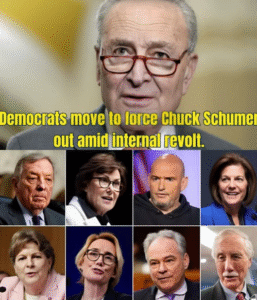DEMOCRATS TURN ON THEIR OWN: Internal Conflicts Shake Party Unity and Political Strategy
In recent weeks, the Democratic Party has found itself in an unusually turbulent position, with internal divisions coming to the forefront in ways that could influence policy, elections, and public perception. Headlines declaring that “Democrats Turn on Their Own” reflect the growing tensions among lawmakers, party strategists, and influential stakeholders, revealing fractures that challenge both party cohesion and broader political strategy. While disagreements within a political party are not new, the intensity, visibility, and potential consequences of these disputes have made this moment particularly notable.
A Party Under Pressure
The Democratic Party currently faces a complex political landscape. With the 2024 presidential cycle behind them and the midterms offering mixed results, lawmakers and leaders are navigating a delicate balance between advancing progressive agendas, maintaining centrist support, and addressing public concerns on pressing issues like the economy, healthcare, climate policy, and social justice.
Amid these pressures, disagreements over policy priorities and strategy have intensified. Progressive factions within the party are pushing for bold reforms on issues such as climate change, student debt forgiveness, and healthcare expansion, while moderates emphasize pragmatism and incremental progress, fearing that ambitious proposals may alienate swing voters. The clash between idealism and pragmatism has led to a public perception of discord, particularly when high-profile lawmakers critique one another’s positions.
Key Flashpoints
Several recent incidents illustrate the degree of internal conflict. For example, progressive Democrats have openly criticized centrist leaders for failing to deliver on promises, accusing them of compromising too much with Republicans and corporate interests. Conversely, centrist Democrats have expressed frustration with the progressive wing, arguing that their approach is politically risky, potentially jeopardizing key legislative wins or electoral prospects.
One of the most visible flashpoints has been debates over spending priorities. Disagreements about funding for social programs versus defense, infrastructure versus green energy, and pandemic recovery measures have occasionally escalated into public arguments on the Senate and House floors. These disputes, amplified by media coverage and social media commentary, give the impression of a party divided against itself, feeding narratives of dysfunction and infighting.
Additionally, the handling of contentious social issues has sparked public clashes. Debates surrounding immigration reform, voting rights, and reproductive legislation have exposed fault lines between lawmakers representing diverse constituencies with different political calculations. In some cases, these disagreements have led to lawmakers openly rebuking colleagues, further fueling the sense of internal strife.
Media Amplification and Public Perception
The role of the media in highlighting Democratic divisions cannot be understated. Headlines emphasizing conflict, criticism, and infighting tend to attract attention and engagement, creating a cycle in which internal disagreements are magnified beyond their immediate political significance. Cable news, digital platforms, and social media feeds frequently highlight clashes between prominent Democrats, often framing disputes as existential battles within the party.
This amplification affects public perception. Polls indicate that while the Democratic base remains broadly supportive, a growing number of Americans express concerns about the party’s ability to govern cohesively. The perception of internal strife can overshadow legislative achievements, making it more challenging to communicate a unified vision for the country and maintain voter confidence.
The Role of Factionalism
Factionalism has long been a feature of the Democratic Party, with progressives, moderates, and centrists representing different ideological priorities and strategies. Historically, these differences have been managed through negotiation, compromise, and the cultivation of party loyalty. Today, however, factional tensions are more visible due to heightened polarization, social media exposure, and the 24-hour news cycle.
Progressives argue that the party must embrace transformative policies to address urgent crises, emphasizing equity, climate action, and social justice. They contend that compromise often dilutes the impact of legislation and fails to meet the expectations of younger voters and activist constituencies. Centrists, meanwhile, stress the importance of pragmatism, coalition-building, and electoral viability, fearing that overly ambitious proposals may provoke backlash and weaken the party’s position in contested districts.
This ideological friction is intensified by generational and geographic differences. Younger lawmakers from urban districts may push aggressively for progressive reforms, while older representatives from swing or rural districts prioritize bipartisan solutions and incremental gains. Balancing these competing priorities requires political skill, negotiation, and patience—qualities that are often tested in moments of crisis or high-stakes decision-making.
High-Profile Examples
Specific incidents exemplify the “turning on their own” narrative. Notably, some Democratic senators and representatives have publicly criticized their colleagues over votes on budgetary legislation, environmental policy, and social programs. These public rebukes often involve high-profile figures, creating headlines that suggest personal animosity rather than policy disagreement.
In addition, internal debates over leadership decisions, committee assignments, and strategic endorsements have fueled tensions. Party leaders must navigate a delicate balance: maintaining authority and discipline while accommodating diverse voices and avoiding alienation of key constituencies. Missteps in this balancing act are often seized upon by political opponents and media commentators as evidence of weakness or internal chaos.
Implications for Governance
Internal conflict has practical implications for governance. When lawmakers are divided, it can slow the passage of legislation, complicate negotiation with opposition parties, and reduce the effectiveness of messaging. In a Congress where party cohesion often determines the success of key initiatives, visible infighting can hinder the ability to achieve policy goals, particularly on contentious issues such as healthcare, climate legislation, and voting rights.
Moreover, public perception of disunity can influence elections. Opponents may exploit these divisions, framing the Democratic Party as incapable of leadership or governance. This dynamic heightens the stakes for upcoming midterm and local elections, where voter confidence in party unity and competence can significantly impact results.
Strategies for Reconciliation
Despite these challenges, the Democratic Party has tools to address internal discord. Leadership can encourage dialogue between factions, highlight shared priorities, and emphasize common goals over differences. Establishing mechanisms for compromise, coalition-building, and transparent decision-making can reduce friction and foster collaboration.
Political analysts suggest that focusing on achievable legislative victories, celebrating successful policies, and maintaining a consistent message can help restore the perception of unity. Additionally, emphasizing the party’s commitment to social and economic progress, while balancing pragmatic considerations, may help bridge the gap between progressive and moderate wings.
Looking Ahead
The Democratic Party’s internal conflicts underscore the complexities of contemporary politics. Balancing ideology, governance, and public perception is a formidable challenge, particularly in an era of heightened polarization and constant media scrutiny. While the perception of disunity is concerning, it also reflects the party’s ideological diversity and the ongoing evolution of its platform.
If managed effectively, internal debate can be a source of strength, fostering innovation, accountability, and responsiveness to diverse constituencies. However, failure to reconcile differences risks legislative stagnation, voter disillusionment, and strategic setbacks. Party leaders must navigate these tensions carefully, ensuring that internal criticism does not translate into public disarray or electoral vulnerability.
Conclusion
“Democrats turn on their own” captures a moment of heightened tension within a major political party, illustrating the challenges of maintaining cohesion in a complex, polarized, and high-stakes environment. Ideological differences, generational divides, and strategic disagreements have brought internal conflicts to the surface, prompting media scrutiny and public debate.
Yet these challenges also offer opportunities. By addressing disagreements constructively, fostering dialogue between factions, and emphasizing shared goals, the Democratic Party can transform internal discord into a source of resilience and innovation. The current moment, while fraught with tension, may ultimately serve as a test of leadership, unity, and the ability to govern effectively in a polarized political landscape.
As Democrats navigate these internal challenges, the party’s response will shape not only immediate legislative outcomes but also its broader political identity and influence for years to come. How leaders manage factional disputes, public perception, and strategic priorities will determine whether internal conflict becomes a source of weakness or a catalyst for renewed purpose and direction.
If you want, I can also break down the key factions within the Democratic Party and analyze their influence on current legislative priorities, providing a more detailed insider perspective on the conflicts discussed in this article.


